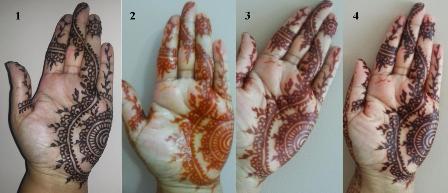To test the colour of our henna paste, Bhupi ran an experiment while temperatures plummeted to -35 over the winter. Using our 100% certified organic henna powder mixed with lemon juice, sugar & tea tree oil, she applied henna to the palm of her hand and followed the same aftercare instructions we give to you, our clients. Photographs were taken over the 3 days.
Picture 1
Henna was applied and is still wet. Sugar solution was applied after the henna had dried. Before going to bed, the crust was gently removed by flaking it off. Coconut oil was applied. A cotton sock was worn to keep the hand warm.
 Picture 2:
Picture 2:
Henna colour the next morning. Coconut oil was applied during the course of the day to keep the hand warm and make it water resistent.
Picture 3:
Henna colour in the evening. As you can see, the colour darkens over a few hours. Coconut oil was applied before going to bed. Pictures 2 and 3 are on the same day. One was first thing in the morning and the other just before bed.
Picture 4:
Day 3, the henna at its peak colour, a very deep dark rich maroon.
Just remember henna stains will vary depending on where on the body it's applied. The darkest colour will be achieved on the palms and feet.
We do NOT add chemicals, additives or preservatives to our henna paste.
To book a consultation or to purchase our organic henna powder or henna cones, please contact us.

 Picture 2:
Picture 2: